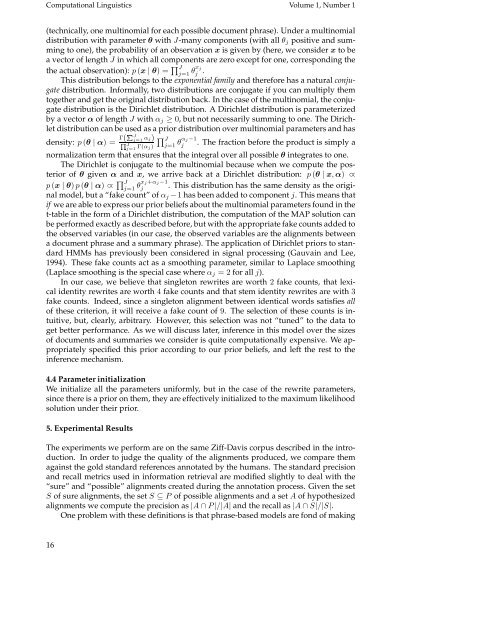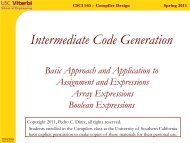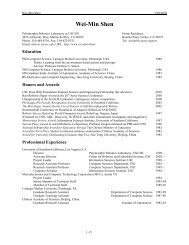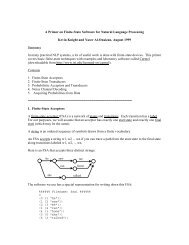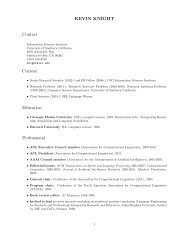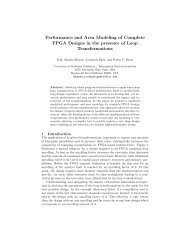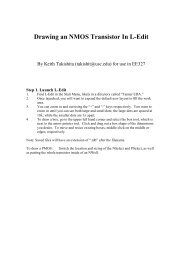Induction of Word and Phrase Alignments for Automatic Document ...
Induction of Word and Phrase Alignments for Automatic Document ...
Induction of Word and Phrase Alignments for Automatic Document ...
You also want an ePaper? Increase the reach of your titles
YUMPU automatically turns print PDFs into web optimized ePapers that Google loves.
Computational Linguistics Volume 1, Number 1<br />
(technically, one multinomial <strong>for</strong> each possible document phrase). Under a multinomial<br />
distribution with parameter θ with J-many components (with all θj positive <strong>and</strong> summing<br />
to one), the probability <strong>of</strong> an observation x is given by (here, we consider x to be<br />
a vector <strong>of</strong> length J in which all components are zero except <strong>for</strong> one, corresponding the<br />
the actual observation): p (x | θ) = �J j=1 θxj j .<br />
This distribution belongs to the exponential family <strong>and</strong> there<strong>for</strong>e has a natural conjugate<br />
distribution. In<strong>for</strong>mally, two distributions are conjugate if you can multiply them<br />
together <strong>and</strong> get the original distribution back. In the case <strong>of</strong> the multinomial, the conjugate<br />
distribution is the Dirichlet distribution. A Dirichlet distribution is parameterized<br />
by a vector α <strong>of</strong> length J with αj ≥ 0, but not necessarily summing to one. The Dirichlet<br />
distribution can be used as a prior distribution over multinomial parameters <strong>and</strong> has<br />
density: p (θ | α) = Γ(§ J<br />
j=1 αj) �J . The fraction be<strong>for</strong>e the product is simply a<br />
¨ J<br />
j=1 Γ(αj)<br />
j=1 θαj−1 j<br />
normalization term that ensures that the integral over all possible θ integrates to one.<br />
The Dirichlet is conjugate to the multinomial because when we compute the posterior<br />
<strong>of</strong> θ given α <strong>and</strong> x, we arrive back at a Dirichlet distribution: p (θ | x, α) ∝<br />
p (x | θ) p (θ | α) ∝ �J j=1 θxj+αj−1 j . This distribution has the same density as the original<br />
model, but a “fake count” <strong>of</strong> αj −1 has been added to component j. This means that<br />
if we are able to express our prior beliefs about the multinomial parameters found in the<br />
t-table in the <strong>for</strong>m <strong>of</strong> a Dirichlet distribution, the computation <strong>of</strong> the MAP solution can<br />
be per<strong>for</strong>med exactly as described be<strong>for</strong>e, but with the appropriate fake counts added to<br />
the observed variables (in our case, the observed variables are the alignments between<br />
a document phrase <strong>and</strong> a summary phrase). The application <strong>of</strong> Dirichlet priors to st<strong>and</strong>ard<br />
HMMs has previously been considered in signal processing (Gauvain <strong>and</strong> Lee,<br />
1994). These fake counts act as a smoothing parameter, similar to Laplace smoothing<br />
(Laplace smoothing is the special case where αj = 2 <strong>for</strong> all j).<br />
In our case, we believe that singleton rewrites are worth 2 fake counts, that lexical<br />
identity rewrites are worth 4 fake counts <strong>and</strong> that stem identity rewrites are with 3<br />
fake counts. Indeed, since a singleton alignment between identical words satisfies all<br />
<strong>of</strong> these criterion, it will receive a fake count <strong>of</strong> 9. The selection <strong>of</strong> these counts is intuitive,<br />
but, clearly, arbitrary. However, this selection was not “tuned” to the data to<br />
get better per<strong>for</strong>mance. As we will discuss later, inference in this model over the sizes<br />
<strong>of</strong> documents <strong>and</strong> summaries we consider is quite computationally expensive. We appropriately<br />
specified this prior according to our prior beliefs, <strong>and</strong> left the rest to the<br />
inference mechanism.<br />
4.4 Parameter initialization<br />
We initialize all the parameters uni<strong>for</strong>mly, but in the case <strong>of</strong> the rewrite parameters,<br />
since there is a prior on them, they are effectively initialized to the maximum likelihood<br />
solution under their prior.<br />
5. Experimental Results<br />
The experiments we per<strong>for</strong>m are on the same Ziff-Davis corpus described in the introduction.<br />
In order to judge the quality <strong>of</strong> the alignments produced, we compare them<br />
against the gold st<strong>and</strong>ard references annotated by the humans. The st<strong>and</strong>ard precision<br />
<strong>and</strong> recall metrics used in in<strong>for</strong>mation retrieval are modified slightly to deal with the<br />
“sure” <strong>and</strong> “possible” alignments created during the annotation process. Given the set<br />
S <strong>of</strong> sure alignments, the set S ⊆ P <strong>of</strong> possible alignments <strong>and</strong> a set A <strong>of</strong> hypothesized<br />
alignments we compute the precision as |A ∩ P |/|A| <strong>and</strong> the recall as |A ∩ S|/|S|.<br />
One problem with these definitions is that phrase-based models are fond <strong>of</strong> making<br />
16


